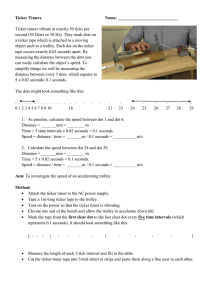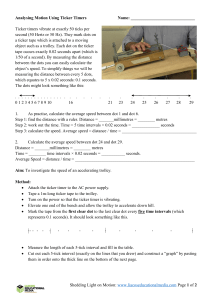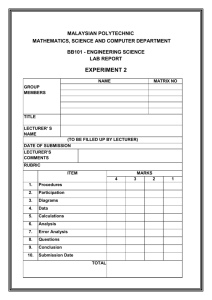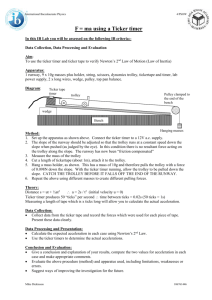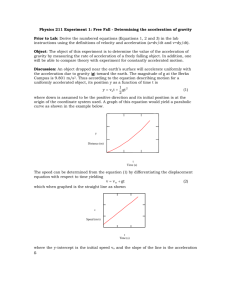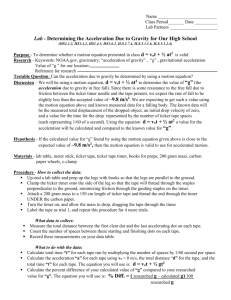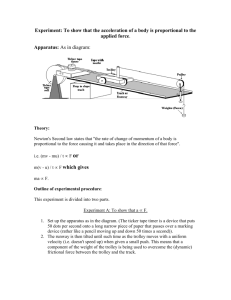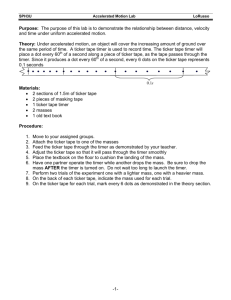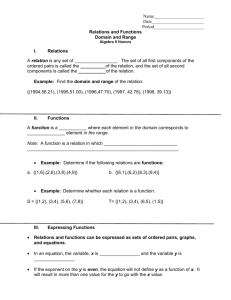Different types of motion
advertisement
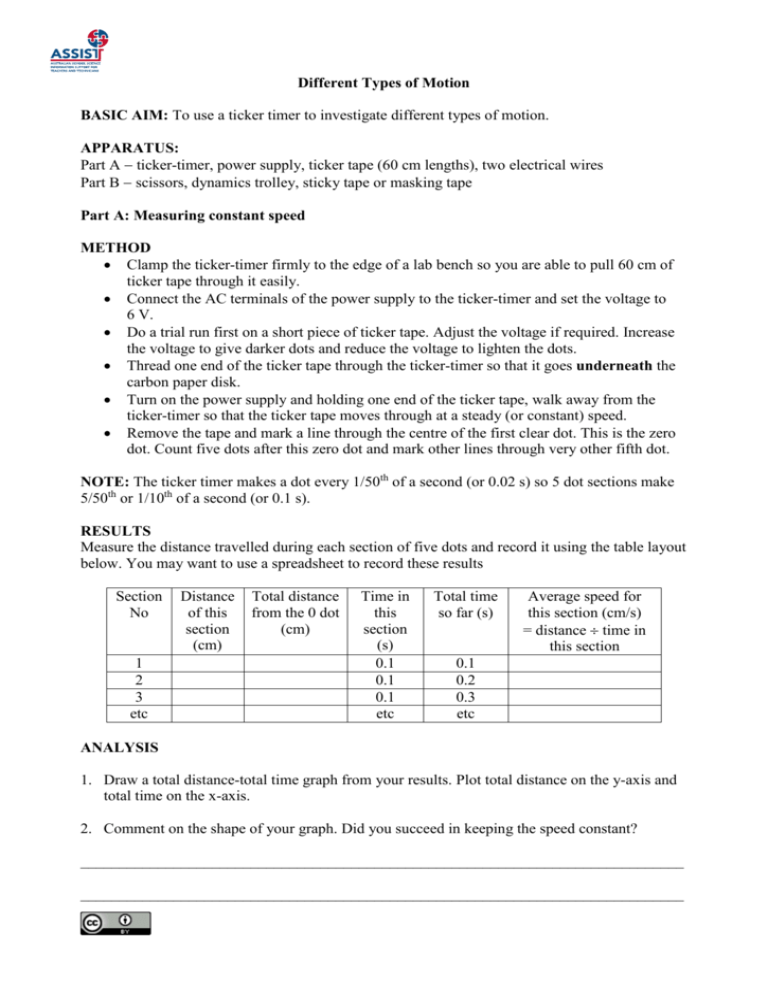
Different Types of Motion BASIC AIM: To use a ticker timer to investigate different types of motion. APPARATUS: Part A ticker-timer, power supply, ticker tape (60 cm lengths), two electrical wires Part B scissors, dynamics trolley, sticky tape or masking tape Part A: Measuring constant speed METHOD Clamp the ticker-timer firmly to the edge of a lab bench so you are able to pull 60 cm of ticker tape through it easily. Connect the AC terminals of the power supply to the ticker-timer and set the voltage to 6 V. Do a trial run first on a short piece of ticker tape. Adjust the voltage if required. Increase the voltage to give darker dots and reduce the voltage to lighten the dots. Thread one end of the ticker tape through the ticker-timer so that it goes underneath the carbon paper disk. Turn on the power supply and holding one end of the ticker tape, walk away from the ticker-timer so that the ticker tape moves through at a steady (or constant) speed. Remove the tape and mark a line through the centre of the first clear dot. This is the zero dot. Count five dots after this zero dot and mark other lines through very other fifth dot. NOTE: The ticker timer makes a dot every 1/50th of a second (or 0.02 s) so 5 dot sections make 5/50th or 1/10th of a second (or 0.1 s). RESULTS Measure the distance travelled during each section of five dots and record it using the table layout below. You may want to use a spreadsheet to record these results Section No 1 2 3 etc Distance of this section (cm) Total distance from the 0 dot (cm) Time in this section (s) 0.1 0.1 0.1 etc Total time so far (s) Average speed for this section (cm/s) = distance time in this section 0.1 0.2 0.3 etc ANALYSIS 1. Draw a total distance-total time graph from your results. Plot total distance on the y-axis and total time on the x-axis. 2. Comment on the shape of your graph. Did you succeed in keeping the speed constant? ______________________________________________________________________________ ______________________________________________________________________________ Part B: Measuring acceleration METHOD Repeat the setup from part A. Join two desks together or use a section of the floor as a ‘track’. Attach one end of the ticker tape to the dynamics trolley. Turn on the power supply and move the trolley forward with your hand, starting from stationary (called ‘rest’), making it reach its maximum speed near the halfway mark. Make it come to a gradual stop near the end of the ‘track’. Remove the tape and mark a line through the first clear dot. This is the zero dot. Count five dots after this zero dot and mark other lines through very other fifth dot. RESULTS Measure the distance travelled during each section of five dots and record it using the table layout below. Perform calculations for the other columns. Section No Distance Total of this distance section from the 0 (cm) dot (cm) 1 2 3 etc Time in this section (s) Total time so far (s) 0.1 0.1 0.1 etc 0.1 0.2 0.3 etc Average speed for this section (cm s-1) = distance time in this section Average acceleration (cm s-2) = change in speed change in time No change in speed ANALYSIS 1. Draw a total distance-total time graph from your results. 2. Describe the motion of the trolley during its motion. Refer to the different sections of the graph e.g. section 1 shows .... and use the words speed, accelerated, decelerated correctly. ______________________________________________________________________________ ______________________________________________________________________________ ______________________________________________________________________________ 3. In which interval was the average speed the greatest? How does the graph show this? ______________________________________________________________________________ 4. In which intervals was the trolley's acceleration: a. positive ___________________ b. negative ___________________ 5. How does the graph you drew indicate positive acceleration (speeding up), and how does it indicate negative acceleration (slowing down)? ______________________________________________________________________________ ______________________________________________________________________________ ______________________________________________________________________________ ______________________________________________________________________________ ______________________________________________________________________________ ______________________________________________________________________________ CONCLUSION Write a conclusion for each part of this experiment. Part A: Measuring constant speed ______________________________________________________________________________ ______________________________________________________________________________ ______________________________________________________________________________ ______________________________________________________________________________ Part B: Measuring acceleration ______________________________________________________________________________ ______________________________________________________________________________ ______________________________________________________________________________ ______________________________________________________________________________ ______________________________________________________________________________ ______________________________________________________________________________
